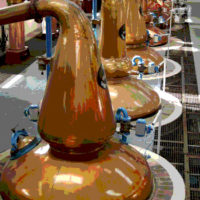When one thinks of a modern food testing laboratory, concepts such as analytical proficiency, quality assurance, certification and regulatory compliance typically come to mind. Customer service might not be the first words to leave the lab manager’s lips when asked about priorities, but keeping customers satisfied is the order of the day for Peggy Cook, Ph.D., who is Director of Laboratory and search Services with Tyson Foods’ Corporate Laboratory and research Services Group, in Springdale, AR. While high-integrity data obviously is paramount, “good service is critical,” Cook says. “The feed mills, growers, our own processing facilities—they are all customers of our laboratories. So we really need to keep on top of things and keep the samples rolling in and results rolling out. Part of the motivation behind upgrading our laboratory information management system [LIMS] and achieving International Standards Organization [ISO] registration is better customer service.”
In addition to the Springdale site, Tyson Laboratory and Research Services comprises facilities in Rogers, AR, Wilkesboro, NC, and a newly acquired South Regional Laboratory in Jackson, MS, which provides microbiological testing for five facilities in central Mississippi and a sixth in Alabama. The four laboratories are keystones in a technical support network that serves many departments throughout the Tyson organization, and are seeking certification to ISO 9001 and ISO Guide 17025 standards with guidance from Saunders Consulting, Inc., based in Rogers, AR, to ensure the highest quality of service. “Internally, we provide technical support to live production, sales and marketing, research and development, processing facilities and quality assurance,” Cook says.
As the world’s largest single producer of poultry products, Tyson Foods dominates the fresh retail and foodservice poultry markets. The company controls all aspects of production “from egg to plate” with further processing being the focus of most of the company’s production facilities. In these processes, poultry is deboned, portion-controlled, breaded, battered and precooked. With the recent acquisition of IBP, Tyson also is the world’s largest producer and marketer of beef and pork, and its line of Mexican Original flour and corn tortillas, taco shells and chips is known throughout the world.
Along with routine testing, the Laboratory and Research Services Group evaluates developments that potentially could affect food production and safety. As new concerns arise for the food industry, such as genetically modified foods and feedstuffs, antibiotic residues, food allergens and new pathogens on the regulatory radar, they are addressed with systematic, statistically designed research projects. Data is analyzed, maintained and made available to key personnel within the Tyson organization. For example, “Washington has been relatively quiet lately, although Campylobacter is beginning to get a lot of attention and regulations for this pathogen could be next,” Cook says. “The laboratories are stepping up our testing in preparation for this.”
“The research functions are very important to our company,” agrees Vice President of Laboratories and Research Services Neal Apple, Ph.D. “These efforts enable Tyson Foods to be on the cutting edge of new developments applicable to food production and food safety. Overall, the impact of conducting good, practical research is potentially great—it enables us to run our business more efficiently, and ultimately, provides safe, wholesome products to our customers.”
Thinking Big
Testing needs and volumes are increasing dramatically across the board as a result of Tyson’s acquisition of meat processing giant IBP, headquartered in Dakota Dunes, SD. The world’s largest producer of fresh beef, pork and allied products, IBP also supplies fully prepared meats for the retail and foodservice industries. It operates more than 60 production sites in North America and has sales offices throughout the world, in total employing 52,000 people.
Integration was in the early going at press time—IBP shareholders voted to approve the purchase of the company by Tyson on Sept. 28—and initially involves organizing the company into two broad channels, a foodservice and international group, and a fresh meats and retail group. Cook and her colleagues already are seeing an “incredible increase in laboratory testing,” she says. In microbiology alone, “Tyson Foods’ Laboratory and Research Services is currently running several thousand samples per year and anticipates that microbiology test volume will triple this year.”
To help meet this demand efficiently, the Springdale facility is undergoing an expansion that is expected to be complete in the summer of 2002. The architectural design, by Rogers, AR-based Hight-Jackson and Associates, calls for an additional 17,500 square feet; the chemistry labs will be expanded in the existing building, and the addition will accommodate new microbiology and research labs. The general contractors are Baldwin and Shell Construction Co. of Little Rock, AR, and Tyson Project Manager Don Whitmire leads the entire construction group and architects. Cook says the addition “will increase the testing capability and offer flexibility to incorporate a greater variety of new testing procedures.”
During the three-year design and planning process, Tyson representatives visited and took cues from several U.S. Food and Drug Administration (FDA), U.S. Department of Agriculture (USDA), National Food Processors Association (NFPA) and private laboratories, resulting in a number of state-of-the-art design features. Incubators and environmental control equipment, for example, all will be computer monitored and controlled to prevent temperature and humidity fluctuations. The separate air-handling system in the pathogen testing area will feature air locks that allow filters to be changed out quickly should organisms become reclassified. Further, the drainage system for the pathogen lab, as well as that of the shelf-life area where D-value studies will be conducted, will go through secondary containment treatment before being discharged.
Cook says the new facility will have 60 to 70 people consisting of senior microbiologists and microbiologists, a senior chemist and chemists, safety officers, field microbiologists, a technical information manager, associate microbiologists, associate chemists and lab specialists. “We are very fortunate because we are very close to the university [University of Arkansas], so we have a good labor pool,” she says. “What is tricky is finding people committed to working nights and weekends. You need to find the tight people and be supportive of them, really let them know that they are appreciated. Microbiology must run seven days a week. Some of the labs recently went to 10-hour work days to meet the demands of rapid assays and sample transfers.”
Easy Access
A main part of coordinating and streamlining the work of lab personnel is a LIMS, supplied by Labware, which has U.S. offices in Wilmington, DE. It works off a central database to which the four corporate laboratories are connected. “This allows one laboratory to easily generate seamless reports from all four locations,” Cook says. “We are able to fully profile products for each customer, and give them a complete history of a particular product in a short period of time.” A barcode scanning system permits easy and accurate sample tracking and management. An analyst, and even the customer waiting for results, simply can look on screen and know precisely where a sample is in the process.
The LIMS has been in place for about five years, and the company has been compiling chemistry and microbiological testing data and comparing plant profiles for some time by computer “When the regulation came down requiring baseline Salmonella testing, we knew it could not be done by paper. There is just too much information,” she says.
In order to better track information generated in laboratories located in Tyson production facilities, the LIMS will be integrated into the plant environment. The system will generate company-wide product averages, product comparisons and summary reports, and aid in performing quality assurance and plant laboratory audits by allowing sample history information to be viewed. It also will provide information to determine laboratory efficiency, according to Cook.
Certainly, the LIMS is essential to lab productivity. “The labs do not buy a piece of equipment that cannot be linked to the LIMS,” Cook says. In terms of instrument acquisitions planned as part of the expansion, she says, “We are hoping to update some equipment and get a gas chromatography/mass spectrometry [GC/MS] instrument and a flash GC instrument for faster turnarounds. We currently have all results out of chemistry in seven days, and we want to improve that.”
Labels and Residues
Gas chromatography is just one tool at an analyst’s disposal in the chemistry department, which provides research and analytical testing for a range of products and customers. The lab maintains USDA Food Safety and Inspection Service (FSIS) accreditation in food chemistry and pesticide residue analysis, and chemistry labs at Springdale are accredited by the Agricultural Marketing Services (AMS) Laboratory Verification Program for the Analysis of Poultry Products Destined for Exportation from the United States to Russia for Pesticide and Antibiotics.
Highly-trained chemists and laboratory specialists use state- of-the-art sample preparation and high-performance liquid chromatography (HPLC) equipment throughout the laboratory. Pesticide residue testing is performed on every flock before transport to the processing facility. In addition, poultry purchased from outside the Tyson system is sampled and tested, “assuring that all Tyson poultry products meet USDA guidelines for pesticide residues,” Cook says.
Pesticide residue testing also is performed routinely on ingredients used in the production of the company’s poultry and swine feeds. Samples of corn, soybean meal and fat, for example, are taken at the feed mills and forwarded to the laboratory for analytical analysis. Finished feeds are sampled and tested on a routine basis, and finished feeds and feed ingredients also are analyzed to ensure that nutritional specifications are met. Tyson’s live production managers and poultry nutritionists use this information to aid in flock management.
Further, all Tyson retail products are analyzed for nutritional components as required by USDA regulations. “The Nutrition Labeling Education Act (NLEA) mandates that specific nutritional components be included on all retail packaging,” Cook says. “The nutritional claims are verified by reanalyzing the products at specified intervals—at least annually. In addition, many products are analyzed to satisfy customer requirements.”
A Mix of Methods
Accreditation also is critical on the microbiology side. All of the labs in the corporate network are accredited to the AMS Laboratory Verification Program for the Analysis of Poultry Products Destined for Exportation from the United States to Russia. They participate in AOAC International and American Proficiency Institute certified check sample programs to assure the uniformity, accuracy and standardization of techniques. Methods are conducted according to the FDA Bacteriological Analytical Manual (BAM), the Association of Official Analytical Chemists (AOAC) and the USDA FSIS Microbiology Laboratory Guidebook. Also, the Tyson Laboratory Manual is adhered to and both corporate and in-plant labs are audited against it.
Microbiology is responsible for monitoring hatchery environments to ensure chick quality, and performing field research and water testing for live production. Technicians perform extensive environmental monitoring of processing facilities, microbiological testing on finished product and testing for research and development to determine shelf life of new products.
Additionally, Tyson’s serology and microbiology department in Wilkesboro holds National Poultry Improvement Plan (NPIP) recognition, and is certified by the University of Georgia Poultry Diagnostic and Research Center and USDA’s Animal & Plant Health Inspection Service for mycoplasma diagnostic work. “These analyses ensure that export specifications are met, and product can be exported to our customers in foreign countries,” Apple says. “Vaccine suppliers are approved before purchase using monoclonal antibody and fluorescence staining procedures.” This laboratory analyzes thousands of blood serum samples from Tyson poultry farms each year to monitor the immunity levels of the flocks to ensure adequate protection against disease. The methods used to perform these analyses include enzyme-linked immunosorbent assay (ELISA), agar gel immunodiffusion tests and serum plate agglutination tests.
Another task for microbiologists and chemists is evaluating new testing technologies for company-wide usage. Throughout Tyson’s laboratories, and in addition to conventional plating techniques, a number of rapid and automated techniques are employed, including gene probes, polymerase chain reaction (PCR) technology and antigen capture techniques. Conventional plating methods also are run. “Our microbiologists and chemists participate in joint research projects with USDA’s Agricultural Research Service to develop and test new and innovative ways to isolate, enumerate and identify foodborne microorganisms,” Cook says.
“Tyson labs use quite a few rapid methods, which we select based on our needs and the potential for the test to improve turnaround times,” she says. “We carefully evaluate all new technologies and make decisions based on where an assay might have a particular application. No rapid method works across the board, and we try to keep an open mind in terms of what technologies meet our needs. Keeping a variety of tests also helps keep us price-competitive.”
She adds, “We have had positive experience with genetics- based tests. They have a place and do very well. They traditionally have not been very user-friendly, but this is changing and it’s been an enormous benefit.”
By the Book
Another important element that assures procedures are carried out correctly and efficiently is the Tyson Laboratory Manual, in which microbiological test methods and standard operating procedures are formalized for all of the company’s labs. This ensures continuity throughout all corporate and plant laboratories with both rapid and conventional testing methods and “makes both training and troubleshooting much more efficient,” Cook says. The manual is used to train Tyson personnel in microbiological laboratory procedures and food safety, and for on-site auditing and training by field microbiologists. It is a key part of the five-day training courses held monthly at the corporate lab in Springdale.
Four field microbiologists travel to all the company’s facilities and audit them twice a year, checking everything from incubator temperatures to analytical protocols. These field microbiologists are responsible for conducting audits of Tyson plant laboratories, which includes routine product testing, environmental sampling and pre-op work. Auditors verify compliance with the Tyson Laboratory Manual, and verify compliance with government regulations on food safety testing. They also serve as contacts for plant personnel by answering questions dealing with food safety, and new innovations and technologies in the food industry.
As an industry leader, Tyson Foods is on the front line of these developments, and its Corporate Laboratory and Research Services is central in their effective evaluation and implementation. By expanding and updating facilities the company’s network of laboratories can better carry out its core mission: providing accurate chemical and microbial analyses to ensure consistent and wholesome food products for customers.
“Tyson has always been proactive with food safety and quality testing. Most of what we do is driven internally and by our customers,” Cook says. “You can’t wait for the regulations to tell you what to do.”
Bruce Flickinger is a freelance writer and editor specializing in the food and pharmaceutical industries.
Tyson Foods: Getting Bigger, Serving Better




